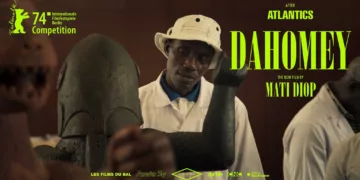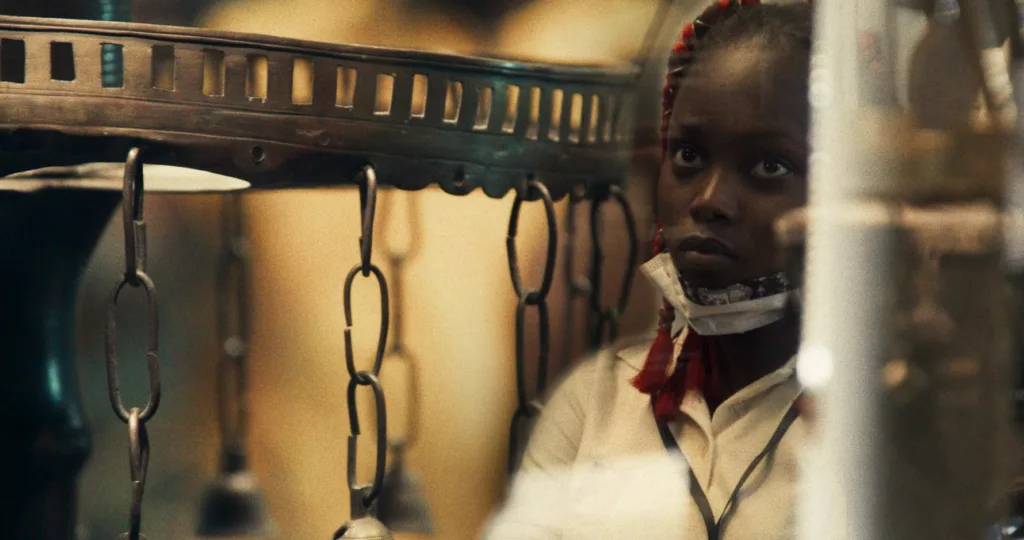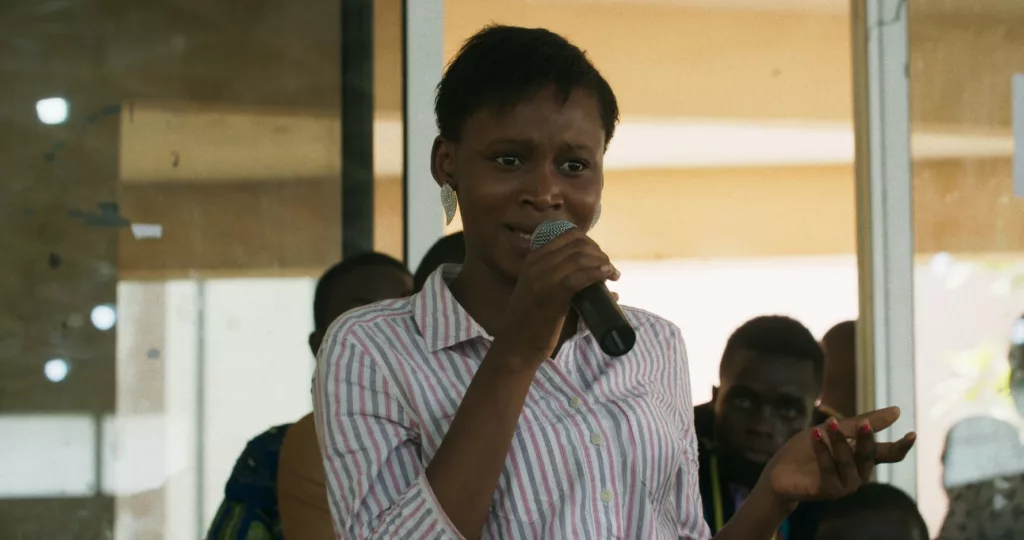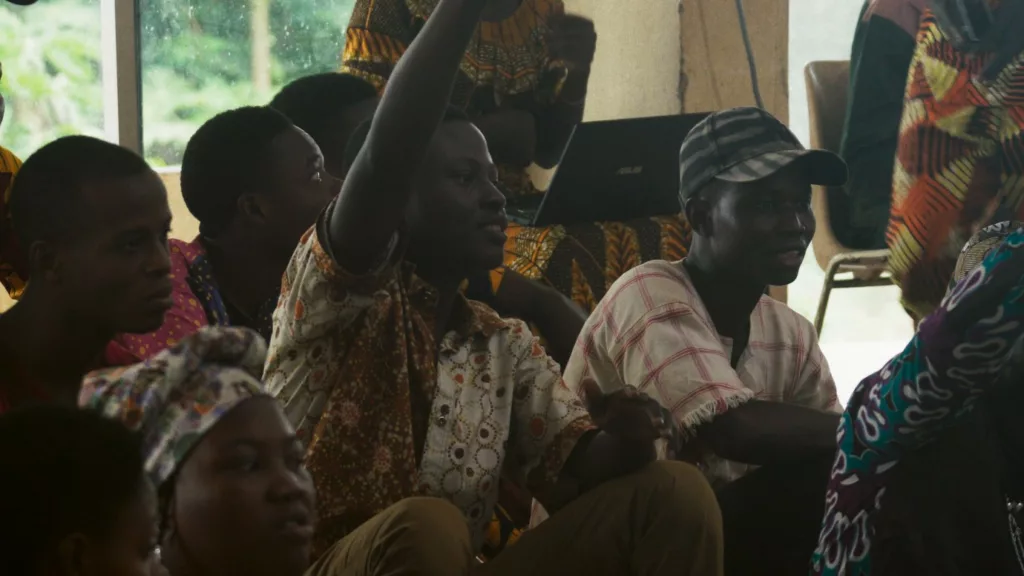When 26 royal treasures plundered from the Kingdom of Dahomey were returned from France to Benin in 2021, Franco-Senegalese filmmaker Mati Diop seized the moment to create an imaginative documentary. Her film Dahomey poetically chronicles the journey of these looted artifacts as they are packed up in Paris and transported back to their homeland over a century later.
Rather than taking a simplistic or didactic approach, Diop injects artistry and subtlety into her documentation of this politically-charged event. The film’s unique style reflects her background as an acclaimed director known for works like the magical realist migrant drama Atlantiques.
As the carved statues and thrones make their bittersweet voyage back to Benin, Diop gives them a fictional voice, letting them brood over years spent hidden away as spoils of colonialism. Their eerie, distorted musings are interwoven with scenes firmly grounded in reality – museum workers carefully packing crates, crowds celebrating the artifacts’ homecoming.
This blending of actuality with poetic symbolism aptly mirrors the way the return of the objects opens up a complicated reckoning with the past and its lingering trauma. Diop relays this nuanced perspective through visionary style rather than heavy-handed messaging, trusting the audience to draw their own connections and conclusions.
The Long Road Home
With hushed reverence, we observe museum workers carefully nestling carved statues of past kings into custom crates, cradling them in foam as if tucking in children for a long slumber. The artifacts are treated with care, but there’s an undeniable poignancy in seeing these symbols of Dahomeyan dignity packaged up like appliances for transit.
As the crates make their flight to Benin, Diop gives the antiquities an imagined consciousness that haunts the film. In the haunting tones of a prophet, the statue of King Ghezo broods over his “captivity in the caverns of the civilized world” where he journeyed so long “in the kingdom of night.” His bitterness over being relegated to “Item #26” simmers. Through this artistic personification, Diop critiques the way artifacts stripped of context become lifeless property.
The contrast intensifies as we switch between the sterile white halls of European museums and vivid glimpses of contemporary African life outside. There, the “works that give strength and power” to Dahomeyan identity are joyfully welcomed home. Yet discordant notes remain. “Everything is so strange, so far removed from the country I saw in my dreams,” Ghezo’s voice echoes as the film questions whether true repatriation is possible after survivals and losses spanning centuries.
By granting the artifacts a voice, Diop radically resists the historical silencing inflicted by colonial powers. Through jarring jumps between past and present, she suggests these objects still bear scars we have yet to fully confront. Their homecoming is cathartic yet complicated, underscoring collective trauma that persists across generations.
Reckoning with the Past
The true power of Diop’s film emerges when she moves from observing the artifacts’ symbolic journey to capturing urgent debates around decolonization unfolding in real time. In an electrifying scene, students at the University of Abomey-Calavi hold a fiery town hall discussing the return of the 26 pieces.
The dialogues pulsing through this raw footage reveal the diversity of perspectives within the young generation that will inherit this colonial legacy. There are those who see the restitution as grounds for celebrating long-overdue justice, however piecemeal. Others cynically dismiss the move as a political tactic by France. Some draw connections back to the slavery fueled by Dahomey’s brutal 19th century raids, wondering if true atonement is possible.
While views clash, the students’ passion resounds with clarity: they urgently seek control over their cultural narrative and tools to reshape identity outside of Eurocentric propaganda. “I was told I was descended from slaves. But I was descended from Amazons,” a woman proudly proclaims. Behind her proud gaze lies centuries of distortion and erasure at the hands of colonizing forces.
The artifacts hold symbolic power, but remain limited in what they can repair. “How many people in Benin can count on three meals a day?” one student pointedly asks. Material reparations alone cannot alleviate systemic inequalities sown under imperialism. Yet the returning objects open a portal to restore what matters most—stories, lineage, and dignity unfiltered by the colonizers who tried to break them.
The debate leaves questions of when true decolonization can occur. But Diop makes clear it hinges on this engaged young generation gaining agency to author their own futures. Though the path ahead remains uncertain, the fire of their conviction sparks hope.
Poetic Documentary
True to her background directing magical realist films like Atlantiques, Diop adeptly fuses documentary realism with poetic symbolism and imaginative touches. While undoubtedly non-fiction, Dahomey channels a lyrical, subjective spirit through unique stylistic choices.
Much of the footage focuses simply on observing—fixed shots studying museum workers packing crates or crowds gathered to welcome the artifacts. But the patient eye of the camera captures subtly evocative details, like a close-up of a worker’s lips moving silently as he inspects a statue, as if in prayerful communion with an ancestor. Diop and DP Joséphine Drouin-Viallard find quiet poetry in mundane rituals surrounding the priceless objects.
Layered over this grounded filmmaking are more mystical elements, like the artifacts’ otherworldly voiceovers or the trippy electronic music shrouding certain scenes. Shots of the moonlit Atlantic coast, echoing Diop’s Atlantic-spanning migrant drama, poetically suggest the vast histories of trauma underlying the artifacts’ return. As much as she chronicles tangible events, Diop conjures an oneiric atmosphere charging everyday reality with uncanny weight.
Rather than foreground her own analysis, Diop’s immersive direction allows audiences to actively parse resonant dualities—past and future, Europe and Africa, dreams and waking life. She trusts in the power of images, spaces, voices, and gestures to spur introspection over didactic messaging. Blending realism with hypnotic style, Diop crafts a “fantasy documentary” that suggests realities rooted in history but also exuding mythical dimensions still being unearthed.
Artistic Risks and Enduring Questions
Dahomey has garnered acclaim for Diop’s daringly inventive approach to dissecting enduring complexities around decolonization and cultural identity. By infusing a real-life political milestone with lyrical artistry and magical elements, she bypasses easy resolutions to instead invoke introspection.
Many celebrate how Diop’s singular vision adds symbolic depth to the artifacts’ profound journey. Through haunting voiceovers and juxtapositions across past and present, she reveals how these objects open up far deeper reckonings with the traumatic fallout of imperialism. Her poetic style suggests realities where physical space and human consciousness intertwine across time.
That said, some critique Diop’s tendency toward conceptual longueurs, arguing the film’s length results in repetitiveness around the halfway mark. But this leisurely pacing seems intended to immerse audiences in lengthy reflections that defy tidy conclusions. Where detractors see meandering focus, others highlight how her measured approach widens space for questioning.
Ultimately, Diop strikingly balances paying tribute to the artifacts’ symbolic “homecoming” while refusing to falsely simplify the enduring wounds and paradoxes borne of colonialism. Moments of celebration meet unsettling confrontations with history’s darkness, embodied in the voice of Ghezo: “I am the face of metamorphoses…within me resonates infinity.” Rather than drive toward an inspirational crescendo, Diop leaves us with a call for relentless dialogue and ever-expanding political imagination unfettered by limiting norms.
Both stylistically bold and ethically nuanced, Dahomey suggests essential questions about imperialism’s living consequences will always eclipse finite answers or remedies. Diop’s singular cinematic lens compels global audiences to sit with dissonances and contradictions too long ignored, seeding new ways of seeing the world still shaped by colonialism’s distorted legacy.
Lingering Resonance
In the closing moments of Dahomey, King Ghezo’s voice lingers over shots of the moonlit Atlantic Ocean that once bore slave ships away from that shore. “I am the face of metamorphoses…within me resonates infinity,” he says, his proud voice now tinged with mournful understanding.
It’s a poetic final point that challenges simple notions of beginning and ending. The artifacts may have completed a long voyage home, but for the people tied to them across generations, the journeys of reconciliation, healing, and agency have only just begun.
Ultimately, Diop has crafted a singular documentary that ably avoids didactic pitfalls or emotional manipulation in favor of nuanced exploration. Through haunted storytelling and arresting imagery, Dahomey poses layered quandaries around imperialism’s enduring wounds more than supplying solutions.
Diop’s film resonates with the wise power of a parable, using the specific story of 26 returned objects to invoke universal questions about how we confront the traumas of history on both political and existential levels. Who owns the past? What does justice look like moving forward? Can we ever truly reclaim what was lost?
By elegantly interweaving real-world events with symbolic resonance, Diop uncovers poetry in unlikely spaces. She leaves audiences reckoning with the infinity that continues unfolding between past and present, dream and waking life, celebration and grief. Within that fertile interplay, Dahomey suggests, perhaps new possibilities await activation.
The Review
Dahomey
In poetically chronicling the charged homecoming of looted artifacts, Mati Diop has crafted a singular documentary that resists easy resolutions or agendas. Through haunting tone and arresting imagery, Dahomey artfully probes the nuances of reclaiming cultural legacy amidst imperialism’s messy aftermath. Diop leaves audiences reckoning with the parallax views found in the space between dream and reality, past and future. Her film’s beguiling power resides in honoring that fertile ambiguity more than imposing conclusions.
PROS
- Unique and poetic cinematic style
- Powerful use of haunting voiceovers and music
- Nuanced examination of complex colonial legacy
- Immersive footage of artifacts' journey home
- Captivating student debates on decolonization
- Celebrates Benin's cultural heritage
CONS
- Pacing lags at times
- Only explores return of 26 objects out of thousands taken
- Doesn't provide concrete solutions/action plan
- Could benefit from more context about Dahomey kingdom's history

















































